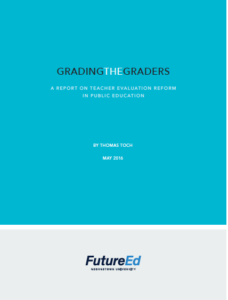Until recently, there was scant attention paid to teacher evaluation in  American public education. The standard evaluation model for the nation’s 3.1 million teachers was a cursory visit once a year by a principal wielding a checklist, looking for clean classrooms and quiet students—superficial exercises that didn’t even focus directly on the quality of teacher instruction, much less student learning
American public education. The standard evaluation model for the nation’s 3.1 million teachers was a cursory visit once a year by a principal wielding a checklist, looking for clean classrooms and quiet students—superficial exercises that didn’t even focus directly on the quality of teacher instruction, much less student learning
The report by Thomas Toch explains how beginning in 2009, policymakers’ stance toward teacher performance changed dramatically. Spurred by a powerful confluence of factors—alarming reports of school districts carrying incompetent teachers on their payrolls, studies undermining public education’s culture of credentialism, the emergence of new ways of measuring teachers’ impact on student achievement, the ascendency of vocal reform advocates, and, above all, forceful federal incentives—nearly every state strengthened teacher evaluation through new mandatory state models, mandates for new local systems, or a menu of state and local options.
Under what has been one of the most rapid and wide-ranging policy responses in the history of public education, forty-six states have demanded more comprehensive teacher scrutiny, and nearly two dozen have directed school districts to weigh teaching performance in addition to experience when granting tenure and the substantial job protections it provides. Grading the Graders examines the changes that the evaluation reform movement has brought to the nation’s schools, the consequences of those changes, and emerging solutions to the many and perhaps predictable challenges that have arisen in the course of pursuing fast-paced change at the core of the educational enterprise.

